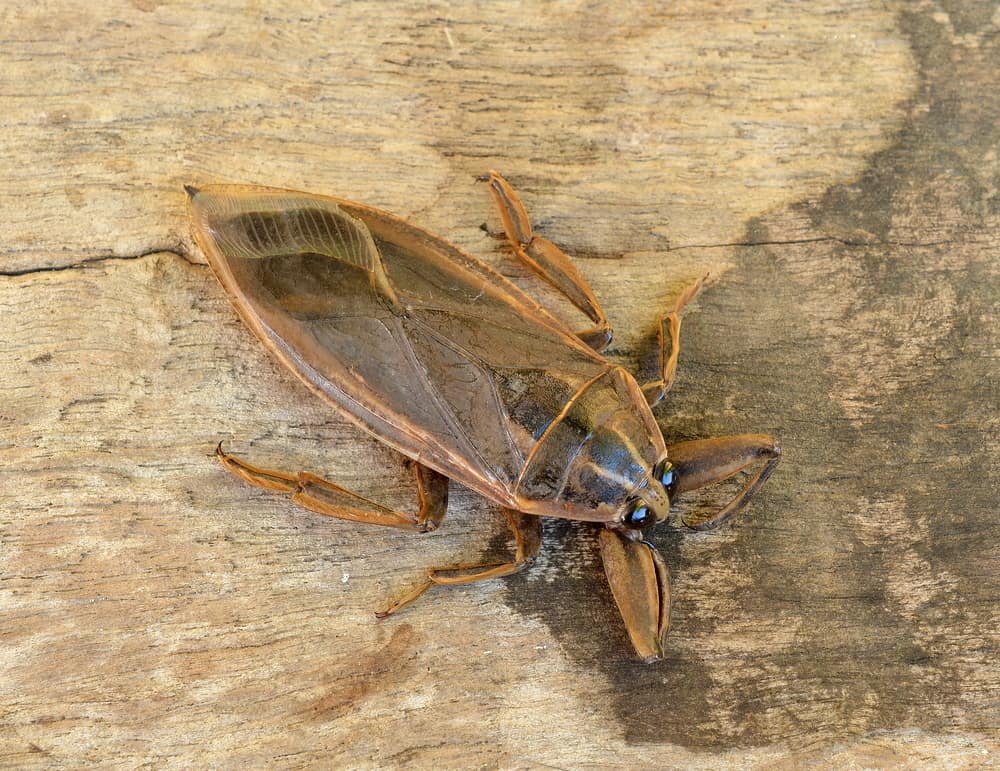It’s easy to mistake water bugs for roaches because they look similar and both enjoy dump places.
However, these crawling creatures come from two distinct orders in the animal kingdom. Hemiptera for water bugs and Blattodea for cockroaches
Most times, the pests people call water bugs are actually oriental cockroaches. Like water bugs, these roaches thrive in damp areas like basements and bathrooms.
But how can one differentiate between water bugs and cockroaches? Worry not! You have landed on the right page.
Below, we’ve highlighted a few distinctive differences between these two pests and how to eliminate them from your home.
Key Differences Between Water Bugs and Cockroaches
Despite their remarkable resemblance, cockroaches and water bugs have unique differences. In this section, we will focus on how these pests differ based on appearance, habitat, behavior, and temperament.
1. Appearance
Although water bugs and cockroaches have oval bodies and six legs, the former appears larger. Water bugs typically measure 2 inches long and 1 inch wide. But some of the largest species of giant water bugs, often found in the US and Canada, can exceed 3 to 4 inches.
On the other hand, roaches usually reach a length ranging between ½ and 4 inches. But their sizes can vary depending on the specific species. Adult brown-banded cockroaches can grow to ½ inch long. American cockroaches can reach 1.5 to 2 inches in length.
Unlike cockroaches, water bugs have no long antennae. Instead, the bugs rock two pincers, which they use to capture and hold their prey. Their back legs also appear flattened and feature tiny hair (cilia) to help them navigate through the water effortlessly.
More so, these water insects have visible x- shaped wings that allow them to move from one water body to another, especially during mating seasons. Similarly, cockroaches have wings too, except for female oriental roaches.
However, roaches do not love to fly around, they only do so when their environment gets too hot or cold.
In terms of color, water bugs are brownish or grayish, with some species being black with brown spots and large brown eyes. Generally, cockroaches have a shiny and black, reddish, or dark brownish shade, though oriental roaches usually appear a lot darker.
2. Habitat
As the name implies, water bugs thrive near water bodies, like rivers, ponds, lakes, and mashes. They prefer to hide in mats of vegetation beneath the water surface, eating anything that catches their attention ( or raptorial legs).
Water bugs rarely venture indoors unless your home offers an ideal environment for their survival. This could include damp spaces like backyard ponds, bathrooms, and swimming pools. They might also get attracted to the light on your porch.
Roaches constantly need moisture to survive. For this reason, they prefer to live among decaying organic matter and wet undergrowth. They usually reside in hallows beneath rocks and forest floors.
In city environments, roaches inhabit sewers, storm drains, dumpsters, and gutters. Sometimes, they can establish their colonies in septic systems.
During the cold seasons, these bugs might venture indoors for warmth and food. They can gain access to your home through the following entry points:
- Gaps beneath doors
- Openings on exterior walls
- Crevices
- Cracks
- Torn window screens
Once inside, they hide in dark, damp areas like
- Under sinks
- Basements
- Bathroom
- Garages
- Attics
Overall, roaches prefer damp places but don’t dwell in the water. In contrast, water bugs find water surfaces more comfortable and ideal for nesting.
3. Temperament and Behavior

Self-preservation is a basic instinct in roaches. But water bugs are much less timid.
Therefore, roaches are less likely to bite compared to water bugs. In fact, cockroaches can hardly pierce through human skin.
Contrariwise, water bugs tend to bite when they sense danger. They also fearlessly hunt animals bigger than them and hold them immobilized to feed.
Being bold makes water bugs easier to catch than roaches. The latter are both timid and like staying hidden in dark places.
Another notable behavior difference is staying in groups. While roaches have a strong group mentality, water bugs prefer solitary lives.
4. Bite Risk
Both roaches and water bugs can bite. But cockroaches only bite humans when threatened or they sense a source of food on your body. More often, they target the feet, hands, fingernails, and eyelashes.
A cockroach bite can sometimes cause mild side effects like irritation, skin lesions, or swelling. In some people, it might cause minor wound infections.
As for water bugs, they can use their piercing or sucking mouthpart to bite you when they feel threatened. While the water bug bite might be painful, it’s not fatal to humans.
5. Eating Habits
While roaches are scavengers, water bugs are voracious hunters.
They often sit motionless, waiting for anything that moves in front of them. If they spot potential prey, water bugs will capture them and inject a powerful enzyme into the prey. The enzymes liquify the prey, allowing the aquatic insect to suck its insides.
Despite their size, water bugs are fearless predators. They can feed on small fish, turtles, small snakes, and sometimes ducklings.
That said, roaches feed on almost everything they find interesting. They consume anything derived from plants or animals, be it starch, sweets, meats, or greasy foods- you name them.
Signs of Water Bug and Cockroach Infestation
Water Bugs
- Tiny black pellets, which could be water bugs droppings or eggs casing
- Water bugs sightings in water bodies in the backyard, including ponds
- Large groups of water bugs congregate around porch lights at night
Cockroaches
- Allergic reactions after being in certain rooms
- Unusual smells
- Strange smears
- Small dark dropping that looks like coffee grounds are found in dark areas, such as cabinets
- Shedding exoskeleton
- Chewed food packages in the pantry
- Brown or red eggs casings
How To Get Rid of Water Bugs and Cockroaches in Your Home

Water bugs can help homeowners eliminate harmful pests, such as mosquito larvae. Despite this benefit, they can also inflict extreme pain with their bites.
Cockroaches often avoid human confrontation and rarely bite. Although this sounds like a good thing, that’s not the case. These insects can contaminate food and water and transmit diseases like gastroenteritis and salmonella.
As you see, it’s paramount to eliminate water bugs and cockroaches in your home. And here are a few ways you can do that.
1. Clean and Remove Food Sources Remove food sources
Keeping your home clean and free of food sources denies roaches and water bugs the fun of staying in your place. Without food and water, they will have to find elsewhere to nest.
When cooking and eating, you may spill some food particles. It’s crucial to remove the food debris and clean spills to avoid attracting roaches.
Besides cleaning, you must cover food and drinks with airtight containers and clean dishes after use.
2. Avoid Moisture
As mentioned earlier, these insects prefer moist places. By fixing faulty pipes, leaking drains, and removing stagnant water outdoors, you can deter water bugs and cockroaches.
Without sufficient moisture, these unwelcome visitors might die off or seek alternative environments that meet their needs.
3. Seal cracks
Cracks provide pathways for roaches and water bugs to come to your house. Sealing them will prevent more insects from coming in and causing an infestation.
Most experts recommend closing potential entry points, including cracks, crevices, and gaps in your walls, floors, and basements, with caulk or steel wool to keep these pesky pests out of your home.
You should also avoid storing firewood or garbage cans against your exterior walls to prevent infestation.
4. Store Garbage Properly
If you don’t have a lidded trash can, it’s time to get one. Storing garbage in a lidded trash can prevent roaches and water bugs from feasting on waste foods.
What if you have trash cans without lids or covers?
In such a situation, it’s wise to dispose of your garbage regularly to prevent attracting cockroaches and other intruders.
5. Use Traps and Bait Stations
Once you have eliminated potential food sources, set up cockroach bait stations in areas frequented by roaches, including the kitchen, bathroom, and other moist areas.
Alternatively, you can buy a gel bait and apply it to cracks and crevices roaches hide. Or you can use bait stations and gel baits simultaneously for the best results.
Additionally, you can use sticky traps, which contain an adhesive pad that traps cockroaches and other bugs in place. Replace the tracks regularly to increase their effectiveness.
6. Hire Professional Exterminators
If the strategies above fail, it’s time to call in the big guns. In this case, contact professional exterminators.
Once you make an appointment, the pest exterminators will visit your home, discuss your pet problem and provide recommendations.
These experts often rely on advanced techniques, like fumigation and traps, to get rid of the bugs.
Bottom Line
Water bugs and cockroaches are among the most common household pests in the US. But surprisingly most people cannot differentiate them because they look similar.
Both insects have six legs and oval bodies, but they have a few distinguishing features. For instance, most roaches rock a brown, black, or reddish coloration and have long antennae. Water bugs often appear darker, with two large pincers.
Water bugs pose no threat to homeowners unless threatened or disturbed. If such a thing happens, the bugs might react by biting. This is something you don’t want because a water bug bite is quite painful.
Unlike water bugs, cockroaches rarely bite humans, but they can contaminate food and water and spread diseases. Fortunately, the few tips above can help you keep your home free from these invaders.
If you are dealing with an infestation, call a professional pest extermination company.
That’s it for today. All the best in your pest control journey!
